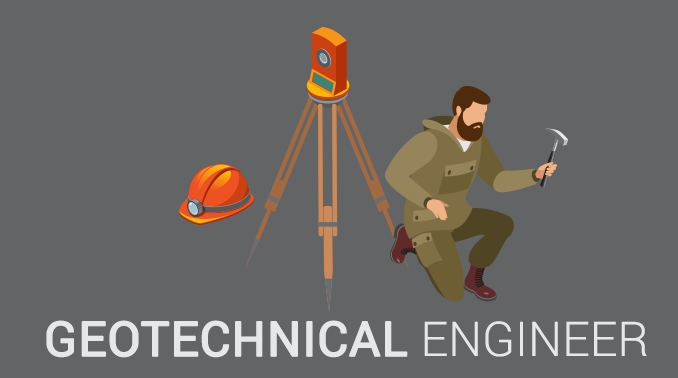The Ultimate Guide To Geotheta
The Ultimate Guide To Geotheta
Blog Article
The 15-Second Trick For Geotheta
Table of ContentsGeotheta for Beginners5 Simple Techniques For GeothetaLittle Known Facts About Geotheta.Things about GeothetaIndicators on Geotheta You Should Know

They conduct site investigations, accumulate samples, do laboratory examinations, and assess data to evaluate the viability of the ground for building and construction projects - Engineer of Record. Based on their findings, geotechnical designers offer recommendations for structure layout, slope security, retaining structures, and mitigation of geotechnical risks. They collaborate with other professionals, such as designers, structural engineers, and construction groups, to ensure that geotechnical factors to consider are incorporated right into the total project layout and implementation
By assessing the habits and properties of soil and rock, they can identify potential geotechnical dangers such as landslides, dirt settlement, or slope instability. Their proficiency helps avoid failings or crashes that can jeopardize lives and home. Right here are some thorough duties and obligations of a geotechnical designer: Website Examination: Geotechnical engineers conduct site investigations to gather data on subsurface problems.
They translate the information to comprehend the buildings and behavior of the soil and rock, including their strength, leaks in the structure, compaction characteristics, and groundwater problems. Geotechnical Analysis and Design: Geotechnical designers examine the data gathered during site examinations to evaluate the stability and suitability of the website for building tasks. They execute geotechnical calculations and modeling to evaluate variables such as birthing capability, settlement, incline security, side earth stress, and groundwater circulation.
The 6-Second Trick For Geotheta
Structure Style: Geotechnical engineers play a crucial role in developing structures that can securely sustain the designated framework. They evaluate the dirt conditions and tons requirements to determine the proper structure type, such as superficial structures (e.g., footings), deep foundations (e.g (https://www.4shared.com/u/w_sNL5Rc/ianhammond2191.html)., piles), or specialized strategies like dirt improvement. They think about aspects such as negotiation restrictions, birthing ability, and soil-structure communication to develop optimal structure styles
They examine building plans, display website tasks, and perform area inspections to confirm that the design suggestions are complied with. If unpredicted geotechnical concerns emerge, they assess the situation and supply suggestions for removal or changes to the style. Risk Assessment and Reduction: Geotechnical designers examine geotechnical risks and risks connected with the task site, such as landslides, liquefaction, or soil disintegration.

Partnership and Interaction: Geotechnical designers work closely with other professionals involved in a job, such as designers, structural engineers, and building groups. Effective communication and cooperation are essential to incorporate geotechnical factors to consider right into the overall project layout and building and construction procedure. Geotechnical designers supply technical know-how, answer queries, and ensure that geotechnical needs are satisfied.
Geotheta Things To Know Before You Get This
Right here are some types of geotechnical engineers: Foundation Designer: Foundation designers focus on designing and evaluating structures for frameworks. They evaluate the dirt problems, tons demands, and website attributes to identify the most proper foundation kind and style, such as superficial structures, deep structures, or specialized techniques like heap structures.
They review the factors affecting incline stability, such as soil residential properties, groundwater conditions, and slope geometry, and create strategies to avoid incline failings and minimize threats. Quake Designer: Earthquake designers concentrate on analyzing and developing structures to endure seismic forces. They assess the seismic threat of a website, assess soil liquefaction potential, and create seismic layout criteria to ensure the safety and security and resilience of frameworks throughout earthquakes.
They do his explanation field screening, gather samples, and examine the gathered information to identify the soil homes, geologic formations, and groundwater conditions at a website. Geotechnical Instrumentation Engineer: Geotechnical instrumentation engineers concentrate on monitoring and gauging the actions of dirt, rock, and frameworks. They install and preserve instrumentation systems that keep an eye on elements such as dirt settlement, groundwater degrees, slope motions, and structural variations to analyze performance and supply early warnings of prospective problems.
6 Simple Techniques For Geotheta
They perform examinations such as triaxial tests, debt consolidation tests, direct shear examinations, and permeability examinations to gather information for geotechnical analysis and style. Geosynthetics Engineer: Geosynthetics designers specialize in the style and application of geosynthetic products, such as geotextiles, geogrids, and geomembranes. They use these products to improve soil security, strengthen inclines, supply water drainage remedies, and control erosion.
They have a tendency to be investigative people, which means they're intellectual, reflective, and inquisitive. They are curious, methodical, rational, logical, and logical. Some of them are likewise social, indicating they're kind, charitable, cooperative, client, caring, practical, compassionate, skillful, and pleasant - Geotechnical Engineers.
In the workplace atmosphere, geotechnical designers utilize specialized software application tools to do computations, develop layouts, and assess data. They prepare records, testimonial project requirements, interact with clients and group members, and coordinate job tasks. The office setting offers a favorable setting for study, evaluation, and collaboration with other experts involved in the project.
The 45-Second Trick For Geotheta
They often go to task websites to perform site examinations, assess geotechnical problems, and collect data for evaluation. These gos to include traveling to various locations, occasionally in remote or challenging surfaces. Geotechnical engineers might perform dirt sampling, conduct examinations, and display building tasks to guarantee that the geotechnical facets of the job are being applied appropriately.
Geotechnical designers likewise work in specialized geotechnical laboratories. Geotechnical laboratory engineers work thoroughly in these environments, taking care of testing devices, operating tools, and tape-recording information.
Report this page